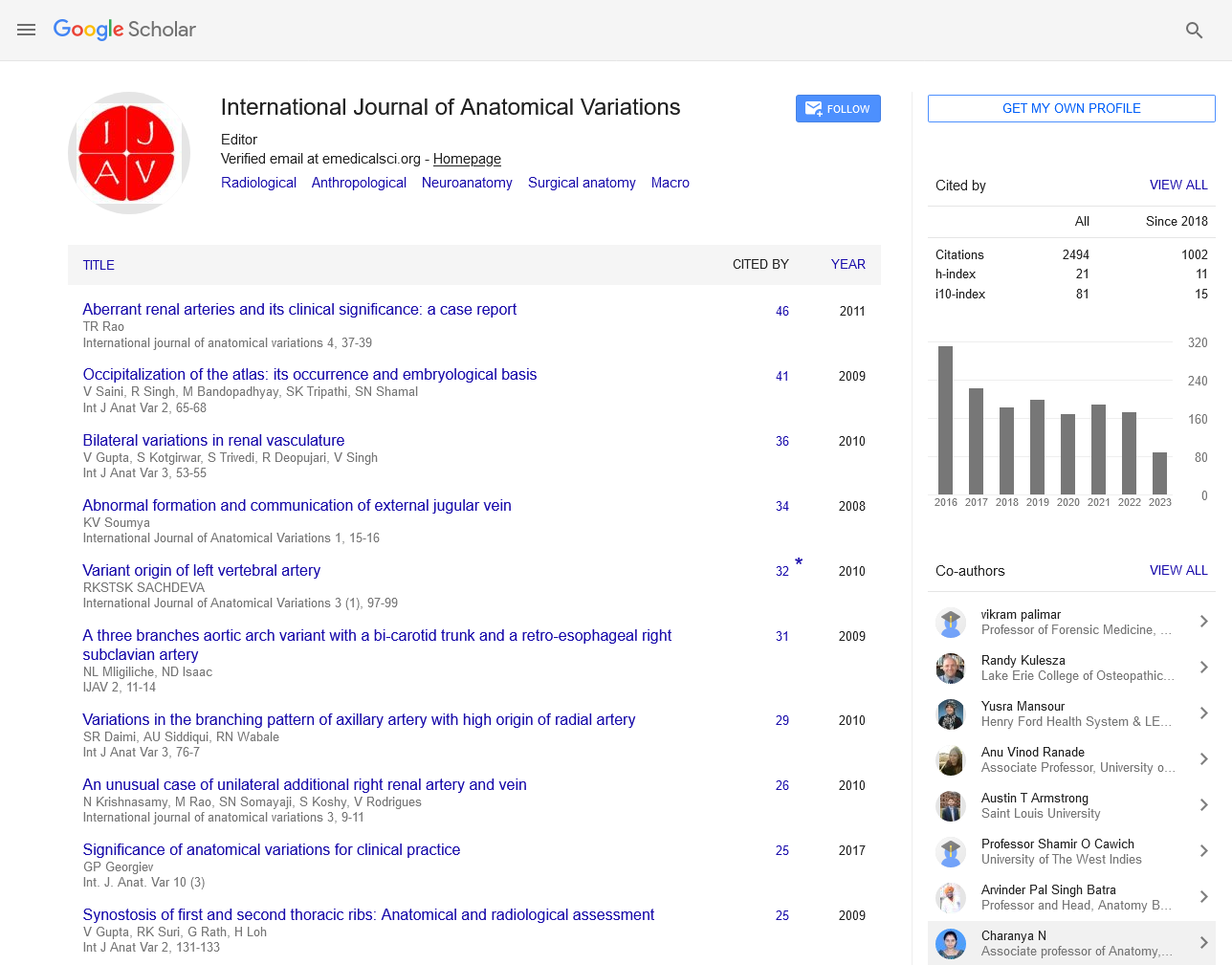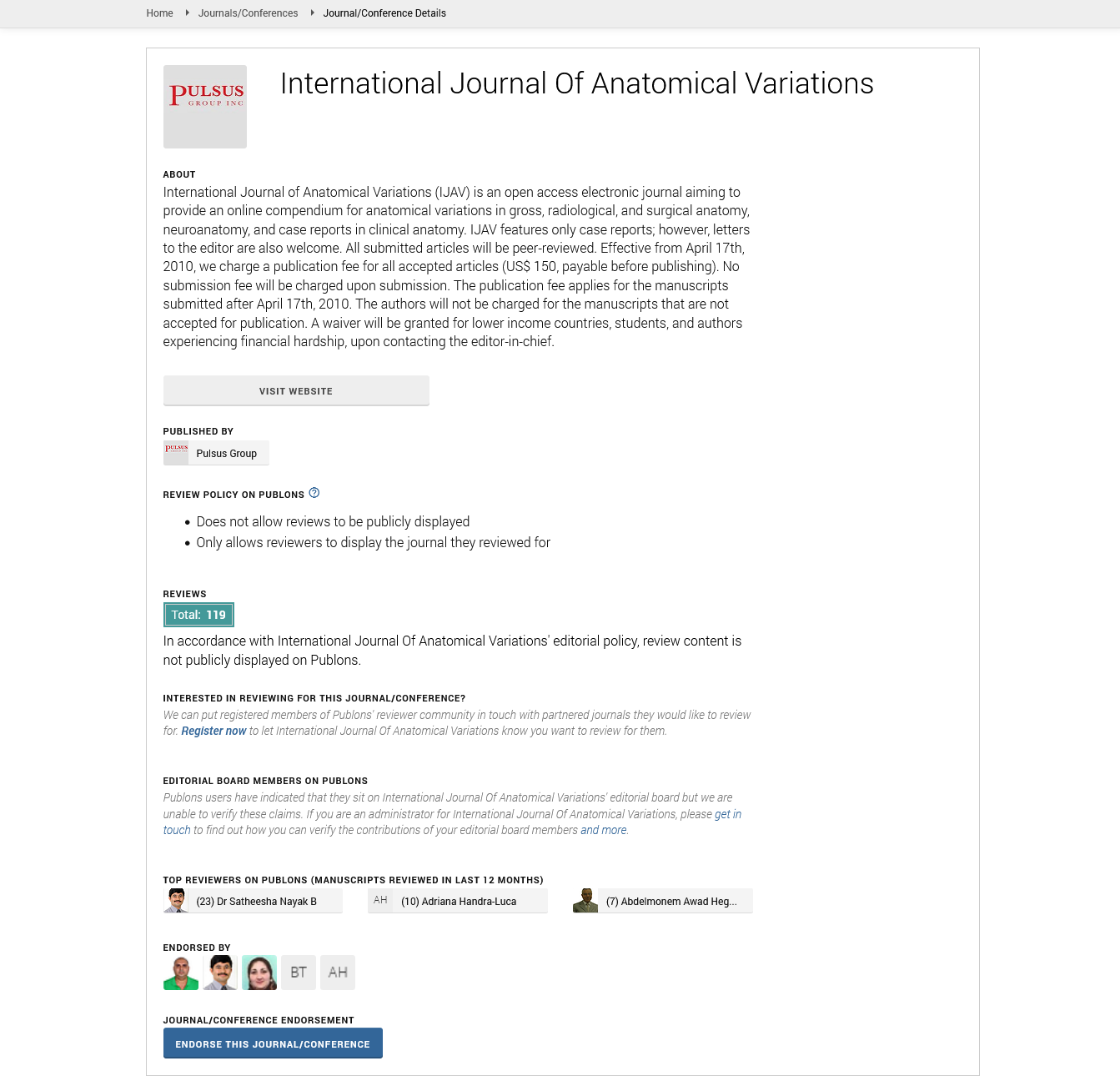Functional Anatomy of the Cardiovascular System: Mechanisms and Implications
Received: 03-Sep-2024, Manuscript No. ijav-24-7303; Editor assigned: 05-Sep-2024, Pre QC No. ijav-24-7303; Reviewed: 19-Sep-2024 QC No. ijav-24-7303; Revised: 24-Sep-2024, Manuscript No. ijav-24-7303; Published: 30-Sep-2024, DOI: 10.37532/1308-4038.17(9).438
This open-access article is distributed under the terms of the Creative Commons Attribution Non-Commercial License (CC BY-NC) (http://creativecommons.org/licenses/by-nc/4.0/), which permits reuse, distribution and reproduction of the article, provided that the original work is properly cited and the reuse is restricted to noncommercial purposes. For commercial reuse, contact reprints@pulsus.com
Abstract
The cardiovascular system is a complex network essential for sustaining life by facilitating the transport of oxygen, nutrients, hormones, and waste products throughout the body. This review explores the functional anatomy of the cardiovascular system, emphasizing the structural adaptations of the heart, blood vessels, and microcirculation that enable efficient hemodynamics. We examine the intricate architecture of cardiac muscle, including the specialized conduction system that regulates heart rhythm, and the structural differences between arteries, veins, and capillaries that support their distinct roles in circulation. The implications of these anatomical features in health and disease are highlighted, including the impact of vascular remodeling in conditions such as hypertension and atherosclerosis. Furthermore, we discuss the relevance of functional anatomy in clinical practice, particularly in the context of diagnostics and therapeutic interventions, including surgical techniques and pharmacological treatments. Understanding the functional anatomy of the cardiovascular system is vital for advancing medical knowledge, improving patient care, and developing innovative approaches to cardiovascular diseases. This comprehensive review aims to enhance appreciation for the complexity and significance of the cardiovascular system's anatomy in maintaining homeostasis and promoting overall health.
INTRODUCTION
The cardiovascular system is a remarkable network that plays a pivotal role in maintaining homeostasis and supporting the physiological demands of the human body. Comprising the heart, blood vessels, and blood, this intricate system ensures the efficient circulation of vital substances, including oxygen, nutrients, hormones, and waste products. At the heart of this system lies the interplay between structure and function—an understanding of the functional anatomy of the cardiovascular system is essential for unraveling the mechanisms that govern cardiovascular health and disease [1].
The heart, a muscular organ, is not only a pump but also a sophisticated structure equipped with a unique electrical conduction system that regulates heartbeat and synchronizes contractions [2]. The architecture of the heart chambers, valves, and associated vasculature facilitates the unidirectional flow of blood, optimizing the delivery of oxygen to tissues while enabling the removal of carbon dioxide and metabolic waste. Meanwhile, the diverse array of blood vessels—arteries, veins, and capillaries—exhibits structural variations that reflect their specific roles in circulation. Arteries, with their thick elastic walls, accommodate high-pressure blood flow, while veins, equipped with valves, prevent backflow and promote venous return under lower pressure. Capillaries, the smallest blood vessels, serve as sites of exchange, allowing for the diffusion of gases and nutrients at the cellular level.
Understanding the functional anatomy of the cardiovascular system extends beyond mere structural knowledge; it provides critical insights into the implications of anatomical variations and pathophysiological changes [3]. Conditions such as hypertension, atherosclerosis, and heart failure illustrate how deviations from normal functional anatomy can lead to significant health consequences. Moreover, advancements in imaging technologies and surgical techniques underscore the importance of a comprehensive understanding of cardiovascular anatomy in clinical practice, enabling targeted interventions and improved patient outcomes [4].
This review aims to explore the functional anatomy of the cardiovascular system, delving into the mechanisms underlying its operation and the implications of anatomical integrity for health and disease. By integrating knowledge of structure and function, we can better appreciate the complexities of the cardiovascular system and its vital role in sustaining life [5].
DISCUSSION
The functional anatomy of the cardiovascular system is integral to understanding how this complex network operates to sustain life. At the core of cardiovascular function lies the heart, a muscular organ uniquely designed to facilitate blood circulation. The intricate architecture of the heart, characterized by its four chambers—two atria and two ventricles—ensures efficient blood flow, separating oxygenated and deoxygenated blood. This separation is crucial for maintaining the body’s metabolic demands, as oxygen-rich blood from the lungs is delivered to tissues, while deoxygenated blood is returned for reoxygenation. The role of heart valves cannot be overstated; they ensure unidirectional flow and prevent backflow, which is essential for maintaining effective circulation [6].
The electrical conduction system of the heart, comprising the sinoatrial (SA) node, atrioventricular (AV) node, and the bundle of His, orchestrates the rhythmic contraction of cardiac muscle. This electrical synchronization is fundamental for effective pumping and is influenced by various factors, including autonomic nervous system regulation and hormonal inputs. Understanding these mechanisms is vital, especially in the context of arrhythmias and other cardiac dysregulations, where deviations in normal conduction can lead to significant clinical consequences.
Beyond the heart, the structural adaptations of blood vessels play a crucial role in determining hemodynamics. Arteries, with their thick elastic walls, are designed to withstand and regulate high-pressure blood flow, while the muscular layer allows for vasodilation and vasoconstriction, modulating blood pressure and flow according to physiological needs. Conversely, veins have thinner walls and larger lumens, reflecting their role in accommodating larger volumes of blood at lower pressures. The presence of valves in veins is particularly important in facilitating venous return against the force of gravity, preventing stasis and promoting efficient circulation [7]. Understanding these anatomical differences is essential for comprehending conditions such as chronic venous insufficiency and varicose veins, where venous structure and function are compromised.
The capillary network serves as the critical interface between blood and tissues, enabling the exchange of oxygen, carbon dioxide, nutrients, and waste products. The thin walls of capillaries, composed of a single layer of endothelial cells, facilitate this exchange, highlighting the importance of maintaining capillary integrity. Dysfunction in capillary permeability can lead to edema, inflammation, and tissue damage, demonstrating how alterations in functional anatomy can have cascading effects on overall health.
The implications of understanding the functional anatomy of the cardiovascular system extend to clinical practice and therapeutic interventions. For instance, advancements in imaging techniques, such as echocardiography and cardiac MRI, have enhanced our ability to visualize and assess cardiovascular anatomy in real-time, aiding in the diagnosis and management of cardiovascular diseases [8]. Moreover, surgical interventions, such as valve repair or replacement and coronary artery bypass grafting, rely heavily on a thorough understanding of cardiovascular anatomy to optimize outcomes.
Pathological conditions such as hypertension and atherosclerosis exemplify how deviations in functional anatomy can lead to significant health consequences. Hypertension, characterized by increased systemic vascular resistance, places undue stress on the heart and blood vessels, leading to hypertrophy, heart failure, and increased risk of cardiovascular events. Similarly, atherosclerosis results from the accumulation of lipids and plaque in arterial walls, compromising blood flow and increasing the risk of ischemic events. Understanding these conditions through the lens of functional anatomy can inform preventive strategies and guide therapeutic approaches [9].
In conclusion, the functional anatomy of the cardiovascular system is a cornerstone of cardiovascular health and disease. By elucidating the mechanisms underlying cardiovascular function and the implications of anatomical integrity, we can enhance our understanding of the complexities of this vital system. Continued research and clinical focus on the functional anatomy of the cardiovascular system will be crucial in advancing our knowledge, improving patient care, and developing innovative strategies for the prevention and management of cardiovascular diseases [10].
CONCLUSION
In summary, the functional anatomy of the cardiovascular system is a foundational element in understanding the complex interplay between structure and function that sustains human life. The heart's intricate design, characterized by its chambers, valves, and specialized conduction pathways, facilitates efficient blood circulation, ensuring the delivery of oxygen and nutrients while removing metabolic waste. The diverse architecture of blood vessels—arteries, veins, and capillaries—reflects their distinct roles in maintaining hemodynamics, emphasizing the importance of structural integrity in overall cardiovascular health.
As we have discussed, deviations in functional anatomy can lead to significant clinical implications, manifesting in conditions such as hypertension, atherosclerosis, and heart failure. These pathologies underscore the necessity for a comprehensive understanding of cardiovascular anatomy in both clinical practice and research, as it can inform diagnostics, therapeutic interventions, and preventative strategies. Advancements in imaging and surgical techniques continue to enhance our ability to visualize and manipulate cardiovascular structures, ultimately improving patient outcomes.
The ongoing exploration of the functional anatomy of the cardiovascular system is vital for advancing medical knowledge and fostering innovative approaches to cardiovascular care. By bridging the gap between anatomical structure and physiological function, we can better appreciate the complexities of this essential system and its critical role in maintaining health and well-being. Continued research in this area will be instrumental in addressing the challenges posed by cardiovascular diseases, which remain a leading cause of morbidity and mortality worldwide.
REFERENCES
- Fontana F, Coppola A, Ferrario L. Internal Iliac Artery Embolization within EVAR Procedure: Safety, Feasibility, and Outcome. J Clin Med. 2022; 11(24):73-99.
- Szymczak M, Krupa P, Oszkinis G, Majchrzycki M. Gait pattern in patients with peripheral artery disease. BMC Geriatrics. 2018; 18:52.
- Chase J. Variation in the Branching Pattern of the Internal Iliac Artery. In: University of North Texas Health Science Center. Fort Worth. 2016: 1-33.
- Nayak SB, Shetty P, Surendran S, Shetty SD. Duplication of Inferior Gluteal Artery and Course of Superior Gluteal Artery Through the Lumbosacral Trunk. OJHAS. 2017; 16.
- Albulescu D, Constantin C, Constantin C. Uterine artery emerging variants - angiographic aspects. Current Health Sciences Journal 2014; 40:214-216.
- Patel SD, Perera A, Law N, Mandumula S. A novel approach to the management of a ruptured Type II endoleak following endovascular repair of an internal iliac artery aneurysm. Br J Radiol. 2011; 84(1008):e240-2.
- Osher M, Semaan D, Osher D. The uterine arteries, anatomic variation and the implications pertaining to uterine artery embolization. J Vasc Interv Radiol 2014; 25:S143.
- Rayt HS, Bown MJ, Lambert KV. Buttock claudication and erectile dysfunction after internal iliac artery embolization in patients prior to endovascular aortic aneurysm repair. Cardiovasc Intervent Radiol. 2008; 31(4):728-34.
- Bleich AT, Rahn DD, Wieslander CK, Wai CY, Roshanravan SM, et al. Posterior division of the internal iliac artery: Anatomic variations and clinical applications. Am J Obstet Gynecol. 2007; 197:658.e651-658.e655.
- Park K-M, Yang S-S, Kim Y-W, Park KB, Park HS, et al. Clinical outcomes after internal iliac artery embolization prior to endovascular aortic aneurysm repair. Surg Today 2014; 44:472-477.
Indexed at, Google Scholar, Crossref
Indexed at, Google Scholar, Crossref
Indexed at, Google Scholar, Crossref
Indexed at, Google Scholar, Crossref
Indexed at, Google Scholar, Crossref
Indexed at, Google Scholar, Crossref
Indexed at, Google Scholar, Crossref






